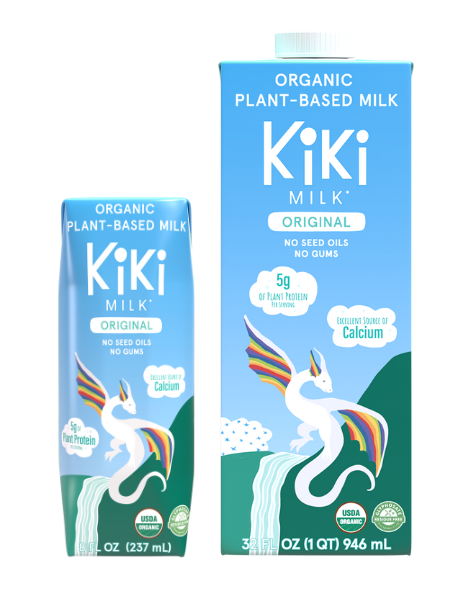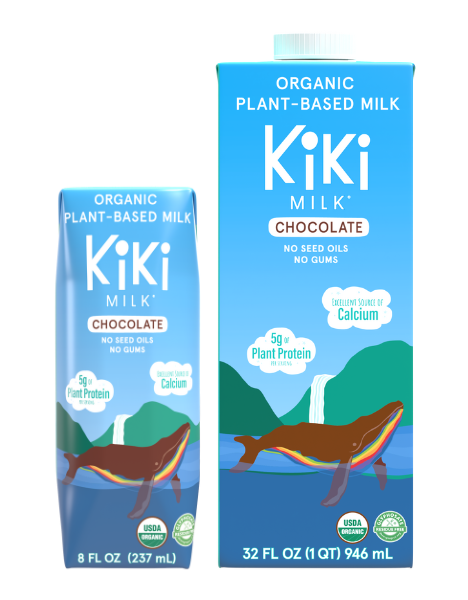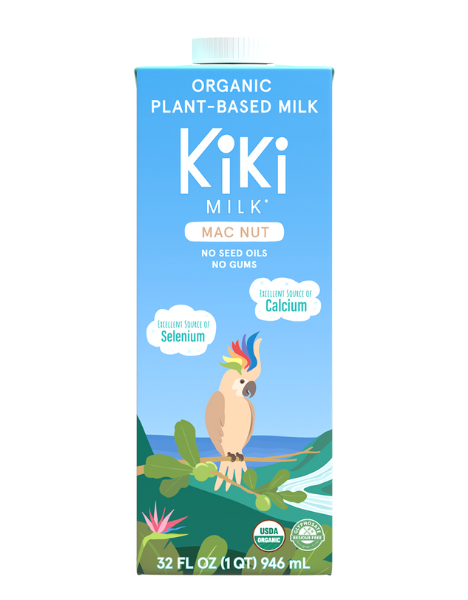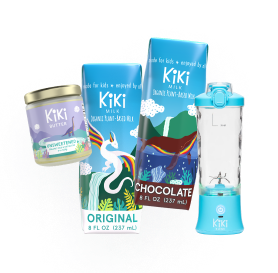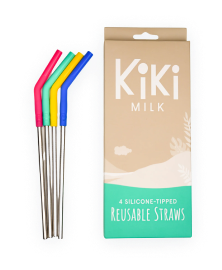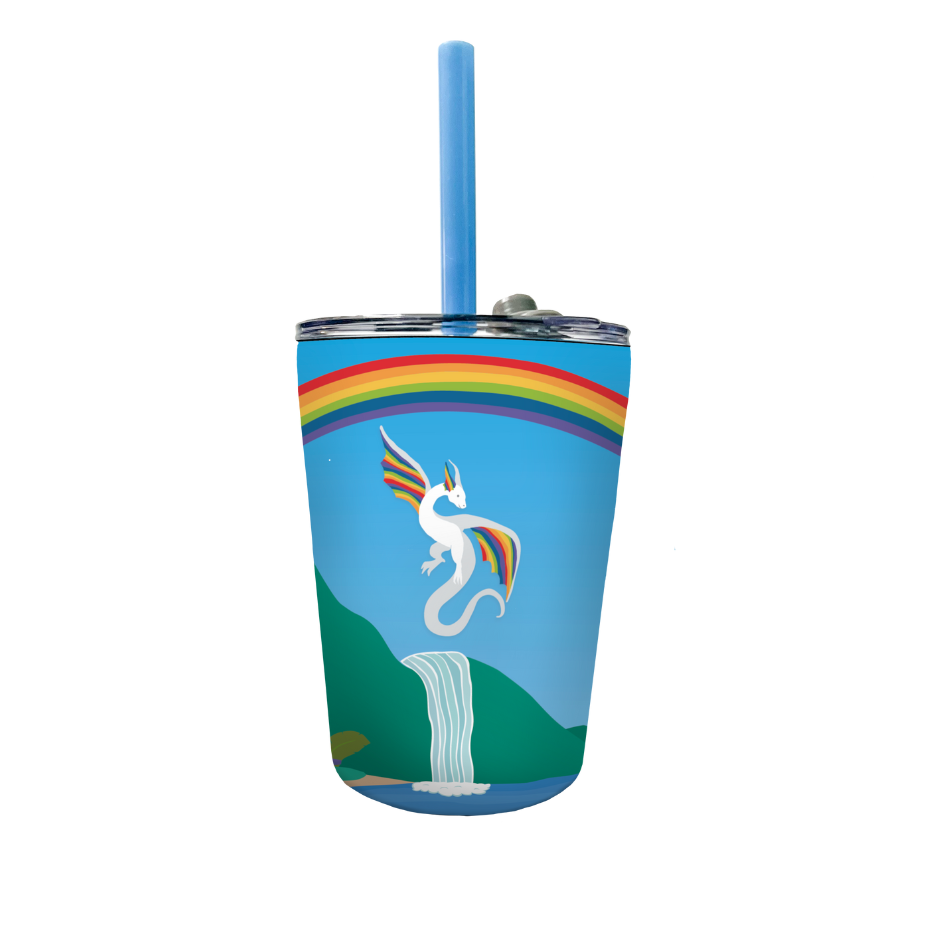We know reading a nutrition label can feel… a little overwhelming.
Tiny fonts. Long words. Percent this, grams that. It’s a lot.
But here’s the thing—knowing what’s on that label is one of the most powerful ways to understand what you’re really feeding your body (and your kids).
The good news? You don’t need to obsess over every number. You just need to know what to look for—and we’re here to help.
🧠 How to Read a Nutrition Label (Line by Line)

Serving Size
This is the amount of food the nutrition facts refer to (ex: 1 cup, 8 oz, 40g).
📌 Why it matters: All the nutrition info (calories, fat, sugar, etc.) is based on one serving, not the whole package. Also check the servings per container—that ice cream pint or snack bag might be more than one, even if it feels like a single serving.
🧠 Rule of thumb: Always check both serving size and servings per container—especially for packaged snacks or drinks that can look smaller than they are.
🥛 Original Kiki Milk Example: One serving = 8 fl oz (one cup)—what you’d typically pour over cereal, blend into a smoothie, or sip straight.
Calories
This tells you how much energy you get from one serving of food or drink.
📌 Why it matters: Calories fuel everything your body does—but it’s not just about the number. Where those calories come from (whole foods vs. processed fillers) matters more.
🧠 Rule of thumb: Focus less on calorie-counting and more on choosing nutrient-dense foods that give your body real energy to work with.
🥛 Original Kiki Milk Example: One cup of Kiki Milk provides 140 nutrient-dense calories from whole food ingredients—no filler.
% Daily Value (%DV)
This shows how much a nutrient in one serving contributes to your total daily needs.
📌 Why it matters: %DV helps you quickly assess if a product is high or low in certain nutrients—based on a standard 2,000 calorie diet (which may not apply to everyone).
🔹 5% or less = low
🔹 20% or more = high
🧠 Rule of thumb: Look for high %DV in nutrients you want more of (like fiber, calcium, iron) and low %DV in things you want to limit (like saturated fat, sodium, added sugar).
🥛 Original Kiki Milk Example: 20% DV of calcium = an excellent source. 2% DV sodium = nice and low.
Total Fat
Fat is essential for brain health, energy, and absorbing fat-soluble vitamins (A, D, E, and K).
🔹 Unsaturated fats (from plants like seeds, nuts, and avocados) = great
🔹 Saturated fats (from foods like coconut, dairy, and meat) = okay in moderation—too much may raise cholesterol
🔹 Trans fats (from ultra-processed foods) = best avoided altogether
📌 Why it matters: Not all fat is bad! The source matters more than the number.
🧠 Rule of thumb: About 25–35% of your daily calories can come from fat. Stick mostly to unsaturated sources and keep saturated fat to less than 10% of total calories.
🥛Original Kiki Milk Example: 6g of total fat from real ingredients like seeds and coconut—no added oils or weird fillers.
Cholesterol
Found only in animal products like meat, eggs, and dairy.
📌 Why it matters: Your body already makes the cholesterol it needs—so most people don’t need to get it from food. Diets high in cholesterol and saturated fat may raise blood cholesterol levels over time. Look for 0mg in plant-based options.
🧠 Rule of thumb: Try to keep dietary cholesterol under 300mg per day—or under 200mg if you're managing heart health.
🥛 Original Kiki Milk Example: 0mg cholesterol.
Sodium
Sodium = salt. It helps with fluid balance, nerve function, and muscle contraction.
📌 Why it matters: Small amounts are necessary, but too much over time can contribute to high blood pressure and strain on the heart.
🔹 5% DV or less = low
🔹 20% DV or more = high
🧠 Rule of thumb: Aim for less than 2,300mg of sodium per day—and even less for young kids. Choosing lower-sodium staples can make a big impact.
🥛 Original Kiki Milk Example: Just 50mg of sodium (2% DV)—naturally low without sacrificing flavor.
Total Carbohydrates
Carbs include fiber, starches, and sugars—and they're your body’s main source of energy.
📌 Why it matters: Carbs aren’t the enemy! What kind of carbs you eat matters more than how many.
🔹 Fiber = your digestion’s best friend—aim for more
🔹 Added sugars = something to keep an eye on (less than 10% of daily calories is a good rule of thumb)
🔹 Natural sugars = naturally occurring in whole foods like fruit, oats, and dates
🧠 Rule of thumb: Look for products with at least 2–3g of fiber and low added sugars per serving.
🥛 Original Kiki Milk Example: 2g of fiber (9% DV) and just 4g of added sugar from organic coconut sugar—never refined or artificial.
Protein
Used for building and repairing tissues, hormones, and enzymes—and it helps keep you full and energized.
📌 Why it matters: Protein is especially important for growing kids, active bodies, and balanced blood sugar. Aim to include some in every meal and snack.
🧠 Rule of thumb: Most people need about 0.8g of protein per kilogram of body weight per day—roughly 46g for women and 56g for men. Kids need less, but it varies by age and growth stage.
🥛 Original Kiki Milk Example: 5g of protein per serving from seeds and peas—more than most plant-based milks on the shelf.
Vitamins & Minerals (Micronutrients)
These often appear in smaller amounts, but they’re vital. Here are a few to know:
🔹 Calcium: Bone health, muscle function
🔹 Vitamin D: Helps absorb calcium, supports immunity
🔹 Iron: Essential for energy and oxygen transport
🔹 Magnesium: Supports sleep, focus, and relaxation
🔹 Potassium: Balances fluids and supports the heart
🔹 Zinc: Key for immunity and wound healing
🔹 Thiamin (B1): Helps convert food into energy
🔹 Selenium, Manganese, etc.: Support metabolism and antioxidant protection
📌 Why it matters: Getting a variety of key vitamins and minerals helps your body absorb nutrients and function best.
🧠 Rule of thumb: Look for at least 10–20% DV of key nutrients like calcium, iron, and magnesium.
🥛 Original Kiki Milk Example: 20% DV calcium, 15% magnesium, 10% zinc, 6% iron—all from real food sources like Aquamin® and seeds.
Ingredient List
Usually found just below the Nutrition Facts panel. Ingredients are listed in order by weight—from most to least.
📌 Why it matters: The first few ingredients make up most of the product. If sugar or gums show up early, that suggests they are present in larger amounts.
🧠 Rule of thumb: Look for products where the ingredients are recognizable whole foods and avoid long chemical names, gums, and processed oils.
🥛 Original Kiki Milk Example: Organic oats and sprouted pumpkin seeds are among the first ingredients. You’ll never find gums, oils, or artificial anything.
📝 Final Tips:
🔹 Always consider context: Is this an everyday food or an occasional treat?
🔹Focus on what the food adds to your diet (fiber, protein, nutrients)—not just what it avoids.
🔹Don’t be fooled by marketing claims on the front. Always scan the nutrition panel and ingredient list on the back.
